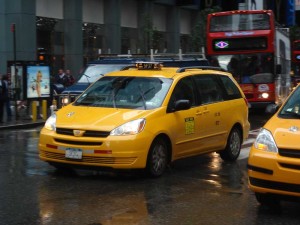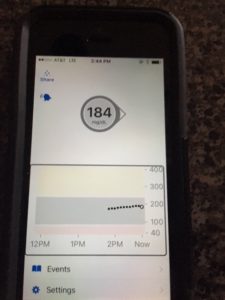Guest post By Ali Krage: A Funny Thing Happened on the Uber Ride to Dunkin’
August 31, 2019 • 5 Comments • Posted in blindness, guest blog, technology for people who are blind, travelOur guest blogger Ali Krage is on a role! In the post she wrote about returning for her last semester at Northern Illinois University (NIU), she talked about the challenges and rewards of being in college when you can’t see.
A week has passed since we published that post, and Ali is already so busy with classes and homework and social activities and her new part-time job at NIU that it may be a while before she can take time to write another guest post. To hold us all over , I’m sharing a wonderful post she wrote while still on summer vacation — this one originally appeared on the Easterseals National Blog. Enjoy!
by Alicia Krage Sometimes I like to share my travel stories with other blind individuals. It gives us a chance to laugh off the mishaps that occur in day-to-day life — or, alternatively, it gives them permission to share their own stories, too. Conversing with other blind people about our experiences is something I really enjoy. The events can be totally unexpected, and it’s comforting knowing we are not alone in these kind of experiences.
Sometimes I like to share my travel stories with other blind individuals. It gives us a chance to laugh off the mishaps that occur in day-to-day life — or, alternatively, it gives them permission to share their own stories, too. Conversing with other blind people about our experiences is something I really enjoy. The events can be totally unexpected, and it’s comforting knowing we are not alone in these kind of experiences.
One recent Saturday morning, I was up bright and early. I wanted to get out of the house for a bit and do some reading at Dunkin Donuts. I used Siri to ask, “What time does Dunkin Donuts open?” Siri confirmed that it was already open. Next step? Using voiceover on my iPhone to schedule my Uber. Once the Uber app gave me my driver’s name, I pasted a text I have drafted in my notes on my phone:
Just so you know, I’m blind so I won’t see your vehicle pull up. Please come get me when you arrive.
This note ensures that I am getting into the right vehicle: the driver will address me by name or introduce himself after approaching me. And so was the case on that early Saturday morning. The ride was short, and when we arrived, the driver offered to lead me to the door.
“That’d be great, thanks!” I replied. “I should be good from there.” I didn’t memorize this layout to the Dunkin near my parent’s house the way I did with the one in DeKalb (that’s where I go to college) but I felt confident I could find the counter to order. I can usually find a Dunkin’ donuts counter by listening for clues — either people ordering their drinks while I enter, or the familiar sound of the card machine.
So my Uber driver and I approach the door, and I pull on the door to open it, and…it wouldn’t budge. That led to an interesting back-and-forth between me and the Uber driver.
”Am I…supposed to push this? Am I pushing on a pull door again?” I asked, laughing. Pulling on doors I’m supposed to be pushing is more common than he realized.
The driver laughed, too. “No, you’re doing it right,” he assured me. “But it’s locked.”
“It is?” I said, surprised. “My phone said it’s open.”
Pause.
I imagined the driver was looking around to see if there was a sign on the door. When he said the drive-through was open, I contemplated briefly. I really was counting on enjoying the coffee shop atmosphere for a while. There was another Dunkin Donuts pretty close, But that would involve taking another Uber back home. We were already here.
“Would you mind taking me through the drive-through?” I asked. “I mean, if it isn’t too much trouble…?” I felt confident he wouldn’t leave me standing there, but I never want a driver to feel obligated. Who knows? Maybe the line of cars was long? I understood if, for whatever reason, he didn’t want to spend his time taking me up to the drive-through. .
His reply came immediately, and there was no trace of annoyance. “Sure, I can do that.”
Truth is, I’ve had driven through a drive-through a few times before in an Uber. I hadn’t known you could actually do that until one day, on my routine trip to Dunkin, my driver asked me if I was going through the drive-through or going inside. “I’m going inside,” I told him. But then, as an afterthought, I asked, “But, for future reference, if I did want to go through the drive-through, how would I do that?”
He told me that I would just add it as a stop, and add my dorm (or where ever I was headed next) as my destination, and let the driver know I was going through the drive-through instead of running inside.
So, I did that. A few times, actually. Most of my drive-through experiences came before night classes, and I went through the drive-through that morning the Dunkin lobby was closed, too. The driver laughed about what an adventure this was so early in the morning, and after we’d determined the main door was locked, he offered perfect sighted guide on our walk back to the car.
As we headed to the drive-through, I asked the driver if he’d mind ordering for me when we got there. “I don’t know where the speaker is…I kind of, well, can’t see it.”
Note: it is not uncommon for me to lighten the mood with some blind humor — or a “blind joke” as I often refer to them.
But back to the story: my driver laughed again and agreed. As I type this now, I realize that since the microphone is typically on the left side, I could have just moved over in the back seat to that side and spoken into the microphone, but I just didn’t want to risk my aim being off. I truly just didn’t feel confident enough. Maybe this will be something I ask sighted friends or family to help me with first before I try it.
Anyway, since it was so early, there was no line. We ordered. “Thank you,” I told him, and just like that, I had my favorite drink in my hands. “What a morning, right?”
We learned that Dunkin had some unexpected maintenance going on, which is why the lobby was closed. And that is exactly why I have drivers lead me to the door rather than just dropping me at the curb and driving away. I guess you never know when something like this could happen!
Being blind, I am learning to just take the mishaps as they come and laugh them off, but I’m still working on this.
I mentioned in a previous post that I’m not a patient person. But these small events — the detours we have to take in life — are stories worth telling. Taking these detours with friends and family who exude nothing but patience and good conversation makes the story even better.



